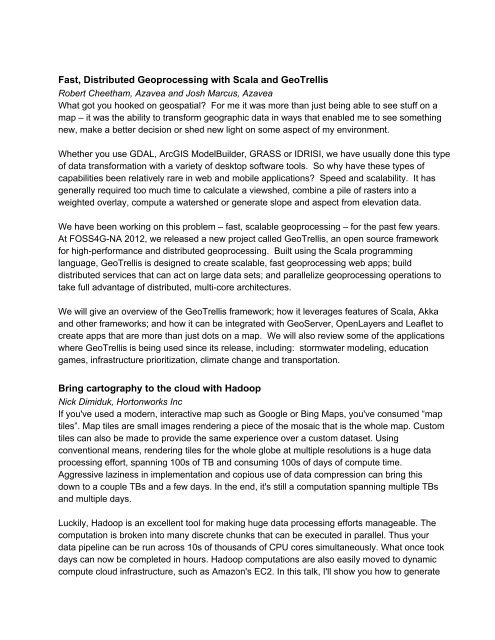FOSS4G North America Conference 2013 Preliminary Program
FOSS4G North America Conference 2013 Preliminary Program
FOSS4G North America Conference 2013 Preliminary Program
You also want an ePaper? Increase the reach of your titles
YUMPU automatically turns print PDFs into web optimized ePapers that Google loves.
Fast, Distributed Geoprocessing with Scala and GeoTrellis<br />
Robert Cheetham, Azavea and Josh Marcus, Azavea<br />
What got you hooked on geospatial? For me it was more than just being able to see stuff on a<br />
map – it was the ability to transform geographic data in ways that enabled me to see something<br />
new, make a better decision or shed new light on some aspect of my environment.<br />
Whether you use GDAL, ArcGIS ModelBuilder, GRASS or IDRISI, we have usually done this type<br />
of data transformation with a variety of desktop software tools. So why have these types of<br />
capabilities been relatively rare in web and mobile applications? Speed and scalability. It has<br />
generally required too much time to calculate a viewshed, combine a pile of rasters into a<br />
weighted overlay, compute a watershed or generate slope and aspect from elevation data.<br />
We have been working on this problem – fast, scalable geoprocessing – for the past few years.<br />
At <strong>FOSS4G</strong>NA 2012, we released a new project called GeoTrellis, an open source framework<br />
for highperformance and distributed geoprocessing. Built using the Scala programming<br />
language, GeoTrellis is designed to create scalable, fast geoprocessing web apps; build<br />
distributed services that can act on large data sets; and parallelize geoprocessing operations to<br />
take full advantage of distributed, multicore architectures.<br />
We will give an overview of the GeoTrellis framework; how it leverages features of Scala, Akka<br />
and other frameworks; and how it can be integrated with GeoServer, OpenLayers and Leaflet to<br />
create apps that are more than just dots on a map. We will also review some of the applications<br />
where GeoTrellis is being used since its release, including: stormwater modeling, education<br />
games, infrastructure prioritization, climate change and transportation.<br />
Bring cartography to the cloud with Hadoop<br />
Nick Dimiduk, Hortonworks Inc<br />
If you've used a modern, interactive map such as Google or Bing Maps, you've consumed “map<br />
tiles”. Map tiles are small images rendering a piece of the mosaic that is the whole map. Custom<br />
tiles can also be made to provide the same experience over a custom dataset. Using<br />
conventional means, rendering tiles for the whole globe at multiple resolutions is a huge data<br />
processing effort, spanning 100s of TB and consuming 100s of days of compute time.<br />
Aggressive laziness in implementation and copious use of data compression can bring this<br />
down to a couple TBs and a few days. In the end, it's still a computation spanning multiple TBs<br />
and multiple days.<br />
Luckily, Hadoop is an excellent tool for making huge data processing efforts manageable. The<br />
computation is broken into many discrete chunks that can be executed in parallel. Thus your<br />
data pipeline can be run across 10s of thousands of CPU cores simultaneously. What once took<br />
days can now be completed in hours. Hadoop computations are also easily moved to dynamic<br />
compute cloud infrastructure, such as Amazon's EC2. In this talk, I'll show you how to generate


